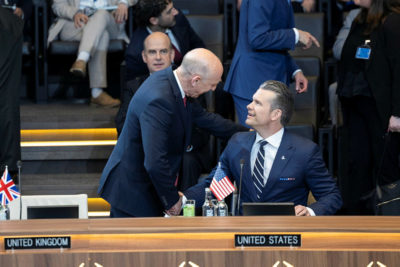Is this militarist realism? Defence dividends for an ‘armour-clad nation’

With the publication in June of the Strategic Defence Review (SDR) and the National Security Strategy (NSS) and with more reports to come, this government is working hard to change the status of ‘Defence’ in the consciousness and economy of the country. ‘If you want peace, prepare for war’ the authors of the SDR tell us, with the promise of a ‘defence dividend’ that brings jobs and prosperity.
We reflect on the two strategy reports, what other critics have highlighted and what they tell us about a narrative of ‘militarist realism’ at this moment.
Part 2 about the ‘whole-of-society’ narrative will be published soon.
Contents
- New strategies, with extra politics
- The rise of centring ‘Defence’
- Militarist Realism
- Militarism: the dominance and state subsidy of the (US) military industrial complex
- Realism: the pervasive atmosphere of permanent war
- No escape from reality….we are not there yet
New strategies, with extra politics
The Strategic Defence Review (SDR) was published in early June with a fanfare. The high rhetoric was matched by the staging of the launch at BAE Systems in Glasgow and a quarrel in Parliament when some in the defence industry – as well as journalists – were given access to the review before MPs. In contrast, the publication of the National Security Strategy (NSS) was hardly registered by the media.
The sequencing of the publications is itself indicative of the new emphasis being placed on ‘Defence’ rather than a wider understanding of security. Whereas the SDR involved a public consultation (although narrowly constructed) and was an inevitable reassessment by a new government in response to a changing global landscape since the 2021 review, the NSS was hurriedly conceived in the wake of Trump coming to power, and – it feels – hurriedly written. While the SDR is published by the Ministry of Defence (MoD), the NSS is published by the Cabinet Office, and something of the Downing Street political culture – evident in other policy emanating from there – and an almost ahistorical perspective, filters through.
For the defence review, the risk of giving it a high profile and rhetorically-laden launch was that it would be met with a corresponding level of critique. This duly emerged from all quarters. An Alternative Defence Review, published by CND and others, is deeply critical of a range of policy choices informed by a narrow militarist rationale. Conflict experts at LSE, Mary Kaldor and Luke Cooper, call the SDR ‘manifestly an exercise in “organised irresponsibility”’ due to it being ‘shaped by past ways of doing things’ and the lack of addressing the serious threats being posed to British democracy:
‘The SDR is stuck in an imaginary past at a time when we face real and dangerous threats. Some of these require military spending but they also require working with like-minded democratic states on a much more holistic social, legal and political response. Not to do so is organised irresponsibility.’
Instead of moving towards an independent European defence system, the defence strategy creates greater dependence on US weaponry, technology and undermines the nuclear Non-Profileration Treaty in the process. Our friends at Drone Wars explore the dangers of the political and media consensus around high-tech military ‘solutions’. An article in the Church Times calls for an emphasis on dialogue against ‘the feeling of propulsion towards a self-fulfilling prophecy of war’. Tom Stevenson, critic of the UK’s role in maintaining US hegemony in his book Someone Else’s Empire, notes in the London Review of Books the ‘vanity’ of the leadership pretensions that still assume a ‘global Britain’ role, alongside the US. He reflects that, ‘There is something self-indulgent about all these declarations of new eras and pages turned’ when just how change will be made is far less clear. The Public Accounts Committee questioned the ‘ever-increasing cost of the nuclear deterrent’ and the lack of transparency around the MoD’s procurement process.
Our own understanding is that these reports are first and foremost political documents, which aim to give off a particular set of signals, as much as laying out a direction of strategic travel.
Scrutiny of the national security strategy was far less widespread. We recommend the analysis by Rethinking Security and Saferworld, who provide detailed and cogent assessments of the strategy’s many failings, including the apparent willingness of the UK government to allow the international legal order and conflict prevention measures to be eroded.

John Healey, Secretary of State for Defence, greets Pete Hegseth, US Secretary of Defence. at the Defence Ministers meeting at NATO, Brussels on 5 June 2025. Photo: UK Ministry of Defence © Crown copyright 2025
Our own understanding is that these reports are first and foremost political documents, which aim to give off a particular set of signals, as much as laying out a direction of strategic travel. What isn’t included is as important as what is. The tone of both the SDR and the NSS is rather different from the Government’s Plan for Change which was published in December last year, which presents a more balanced understanding of national security.
The subtitle of the NSS is narrowly-focused, simplistic and fearful: Security for the British People in a Dangerous World. This is reflected in the contents. Despite it remit to consider the wider security issues, only brief mention is made of the impact of climate change or another pandemic, both of which were identified as relatively high likelihood and high impact in the latest edition of the National Risk Register also published this year. Were these issues seen as too politically toxic to dwell on in the NSS? The report also inadequately reflects the security interests of the array of government departments and other organisations identified as the ‘national security community’, let alone threats posed by inequality and political instability that even the MoD have recognised in their ‘human security in Defence’ publication.
Every single image in the NSS is a military one with the exception of Ernest Bevin, shown in his role as Foreign Secretary from 1945-51, which is leveraged by the report to hark back to pulling together spirit of the first and second world wars, and the role of the post-war Labour government in founding NATO. When the NSS isn’t talking about defence capabilities and conflict, it is using the language of rivalry and friction: ‘unless we do more to increase our competitiveness and sovereign strengths…we will lose our ability to generate wealth and risk falling behind our adversaries’. The possibilities for ‘cooperation’ are framed by ‘strong alliances’ and ‘competitive strategic advantages’ rather than more genuine peacebuilding efforts, and ‘collective security’ is based on defence alliances and partnerships such as NATO and AUKUS.
With its ‘hardening and sharpening’ language, the NSS leans into the divisive politics of those who ‘see the rules being ignored, undermined or flouted by others, to their disadvantage’; it recognises that ‘many people in the UK feel exposed to the negative effects of globalisation – such as de-industrialisation and mass migration’ but says nothing to moderate the more divisive political narratives around these effects. While this reflects where the political and media are currently focused it does not represent the views of so many others, and those who are part of UK communities who have been on the sharp end of conflict and displacement elsewhere. Despite the stated aim to ‘unify’, there is no attempt to acknowledge differing opinions and bring them together, only the blunt promise that the government will be ‘more unapologetic and systematic in pursuit of our national interests’.
The rise of centring ‘Defence’
Months before the SDR’s publication, and after his meeting with the new US president Donald Trump in Washington in February, Keir Starmer announced in Parliament that there would also be a new national security strategy. He pre-empted both reports by signalling a significant shift in the UK’s ‘posture’:
‘We must change our national security posture because a generational challenge requires a generational response that will demand some extremely difficult and painful choices. And through those choices, as hard as they are, we must also seek unity. A whole society effort that will reach into the lives, the industries, and the homes of the British people.’
After announcing increases in defence spending in this parliament and the next, he went on to invoke post-war Labour leaders and harness the promise of opportunity and economic security to the defence agenda. It is worth quoting at length to hear the language and the promises made:
‘We will have to ask British industry, British universities, British businesses and the British people to play a bigger part, and to use this to renew the social contract of our nation—the rights and responsibilities that we owe one another. The first test of our defence policy is of course whether it keeps our country safe, but the second should be whether it improves the conditions of the British people. Does it help provide the economic security that working people need? Because, ultimately, as Attlee and Bevin knew, that is fundamental to national security as well. We will use this investment as an opportunity. We will translate defence spending into British growth, British jobs, British skills and British innovation.’
As promised, the SDR and NSS put ‘Defence’ (as they write it) front and centre in the government’s plan for both security and growth. This has been the direction of travel over a longer period. Defence-led industrial policy, its link to prosperity and ‘whole-of-society’ narratives, have been gearing up in recent years and were key elements of the 2021 Integrated Defence Review. But with its arrogant discussion about the influence of ‘global Britain’ this review still had plenty of time for the soft power of aid and diplomacy; the language of human rights, law and equality was more evident, and prosperity was not so linked to defence as an ‘engine for growth’.
Developments since then have further opened the door to the NATO-first, tech-first priorities. Calls by military chiefs and politicians for the UK to be placed on a ‘war-footing’ in response to a ‘1937 moment’ began not long after the Russian invasion of Ukraine in 2022. These fears – driven significantly by the mainstream media – have been more instrumental in the full throttle rearmament policy than Trump’s more recent threat to retreat from Europe. The Labour government has been courting Big Tech as a vehicle for UK growth and a route to increased competitiveness around AI, autonomous weapons, and surveillance – such as specialist companies like Anduril – just as household-name tech companies start to win defence contracts and provide data-based surveillance services for powerful militaries.
His clunky promise of an ‘armour-clad nation’, while cutting aid and talking of ‘more tough choices’ in order to increase defence spending, also suggests an inability to see, or a determination to ignore, the moral questions and social consequences from his funding decisions.
Starmer starts his introduction to the SDR with, ‘My first duty as Prime Minister is to keep the British people safe’. He also states that it is his ‘number one mission to deliver economic growth’. Conveniently he seems to be able to visualise a world in which ‘Defence’ will ‘create a secure and stable environment in which businesses can thrive’. Apart from any other concern about what this world will look like, this loads rather a high expectation on ‘Defence’ which is expected, as the SDR puts it, to ‘deliver for the UK economy while delivering for the warfighter’.
Many commentators noted the relish with which the SDR was launched into the world. As one put it, the ‘PM’s defence review reveal mixes fighting talk with wide-eyed wonder at promise of a war dividend’. His clunky promise of an ‘armour-clad nation’, while cutting aid and talking of ‘more tough choices’ in order to increase defence spending, also suggests an inability to see, or a determination to ignore, the moral questions and social consequences from his funding decisions. As Richard Norton-Taylor has observed, the ‘battle ready’ rhetoric used to deliver the SDR seems intended – in the Labour government’s often authoritarian style – to squash dissent about the credibility of some of its claims and aims.
Militarist Realism
The ‘common sense’ idea that preparation for war is a necessity that no reasonable person should question is written right into the SDR with its vision-defining ‘if you want peace, prepare for war’ quotation. Many, many questions lie outside of this framework. Is this a good use of limited resources, given the pain involved with welfare cuts after a long period of austerity? Could rearmament fuel an arms race and provoke more conflict? Does increasing the nuclear arsenal and bringing US nuclear weapons back onto UK soil not make the UK financially and militarily vulnerable? If the world really is a more dangerous place, shouldn’t we be hedging our bets by adequately funding aid and doing everything we can to sustain and improve international bodies that at least provide some rule of law and opportunities for cooperation?
We have been thinking about this militarised ‘moment’, with its all-encompassing rhetoric and aims, as one that we at ForcesWatch call ‘militarist realism’.
For us, one of the biggest questions that will never be addressed is, what does it mean for this country to create local and national dependence on destructive and divisive industries and base our collective prosperity on it? And what price is to be paid by those in other parts of the world who are on the receiving end of the products that bring us prosperity?
We have been thinking about this militarised ‘moment’, with its all-encompassing rhetoric and aims, as one that we at ForcesWatch call ‘militarist realism’. This is informed by the idea of capitalist realism conceived by the philosopher and educator Mark Fisher in the period after the financial crash of 2008. He posited that in an era of capitalist realism there is a ‘pervasive atmosphere’ that there is no alternative to it as a ‘viable political and economic system’. In thinking about how it has become impossible to imagine an alternative, he reflected that it suggests a seemingly ‘post-political’ situation in which considerations are only given to decisions within the confines of capitalism and confined to mitigating its worst effects.
We are not talking here about ‘military realism’ which is a term describing an evolving pragmatism within warfare. To be ‘militarist’ is to forward and support a military agenda. We refer back to the words of Cynthia Enloe from her 2007 book Globalization and Militarism:
‘To become militarised is to adopt militaristic values and priorities as one’s own, to see military solutions as particularly effective, to see the world as a dangerous place best approached with militaristic attitudes.’
A ‘militarist realism’ perspective helps in examining two qualities of the ‘new era’ described in these recently published defence and security strategies. The first is about militarism and who benefits from it, and the second is about realism and the language and culture which this generates to support the policy.
Militarism: the dominance and state subsidy of the (US) military industrial complex
In relation to capitalist realism Fisher argued that because the banking system is so fundamental to capitalism, when banks were failing in 2008, huge resources were diverted to bailing them out and the financial system as a whole. He described the ‘business ontology’ that was purposely pushed ‘in which it is simply obvious that everything in society, including healthcare and education, should be run as a business’.
It has been many decades since the military industrial complex was famously identified by Eisenhower in his farewell presidential address as of such size and influence that it has ‘grave implications’ for ‘the very structure of our society’. Yet, in the face of the highly visible escalation and horrific destruction of human life and communities in Ukraine and Gaza, the question being asked now is not should we be reducing arms production and bolstering other methods of influence and alliance, but how to rearm and divert resources away from other security measures in order to do so.
Despite a political focus on building up the European arms industry, it is very likely that the US will significantly benefit from more defence spending, at least in the short term.
The data shows that while the UK spends about half of its annual defence procurement budget through companies headquartered outside of the country, the share that goes to US companies is reducing. While there are greater efforts to help smaller companies in the UK benefit from defence expenditure, the proportion they receive is only around 5% with the top five companies accounting for one third of all procurement spending. A much larger share of the EU’s defence budget goes to US companies. Despite a political focus on building up the European arms industry, it is very likely that the US will significantly benefit from more defence spending, at least in the short term. Since the SDR was published, the UK government have announced the purchase from the US of a squadron of new fighter jets able to carry tactical nuclear weapons. And along with other Nato countries, it has also promised an increase in defence spending to 5% of GDP over the next decade, at Trump’s behest.

John Healey, Secretary of State for Defence addressing the RUSI Land Warfare Conference on 17 June 2025. Photo: UK Ministry of Defence © Crown copyright 2025. Click image to enlarge.
In the days after the Strategic Defence Review (SDR) was launched, the inaugural Defence Industrial Joint Council was held, and co-chaired by the Defence Secretary and the CEO of BAE Systems. This council aims to ‘enable decision-making and communication between the MoD and its industry partners’, as if the relationship is not already far too close. Its members include at least seven prime defence companies, five defence tech companies (including Palantir), three trade unions and defence investors. The government has also announced new public subsidies for the arms industry through a new UK Defence Innovation body, as well as £6bn for munitions during this parliament, a new Defence Exports Office and reforms to speed up procurement.
At the annual RUSI Land Warfare conference three weeks later, the Defence Secretary John Healey referenced the SDR’s commitment to a ‘tenfold increase in the Army’s lethality’ as he spoke in front of an array of logos from many of the largest defence contractors. The creep of corporations onto the conference’s branding in recent years is but one signal of how their relationship to the country’s military is increasingly viewed as structural, whatever the democratic concerns this creates.
While selected defence workers will gain from these contracts, how much the country as a whole will benefit is a question that has not been entirely absent, with media debates about the validity of military keynesianism as a tool for generating growth.
While the benefits for large defence companies are clear, the pay-off for communities is the promise of jobs and wider wealth. In Starmer’s introduction to the NSS he states that a ‘defence dividend’ will ‘renew industrial communities the length and breadth of our country’. Government ministers have been courting the defence industry and their workers in their workplaces. The Port of Barrow was given a royal title for its building of nuclear submarines with Starmer grandiosely claiming that it is a blueprint for ‘delivering security for working people and renewal for our country’. He visited the Leonardo UK factory in Luton where workers will begin making the StormShroud drone after being awarded a large RAF contract, and received arms company workers at a reception in Downing Street.
While selected defence workers will gain from these contracts, how much the country as a whole will benefit is a question that has not been entirely absent, with media debates about the validity of military keynesianism as a tool for generating growth. Apart from the fact that Keynes was an advocate of government spending ‘in the interests of peace and prosperity’ instead of ‘war and destruction’, as the economist Michael Burke explains, military spending has one of the lowest employment multipliers of all economic spheres. And as ‘left-behind’ towns become economically reliant on military contractors, they become vulnerable when the contract, or policy, changes.
Khem Rogaly, who has produced a number of valuable reports on the arms industry for the Common Wealth think tank, states that as military industries are increasingly high tech employers, the link between spending and number of jobs created is reduced, and more than half of this employment is located in the south of England. Not only does investment in public services and renewable energy create more jobs but these kind of outputs benefit society more generally. He goes on to reflect:
‘The government and the opposition are united in presenting “rearmament” as a difficult but necessary step – to keep Britain safe in a turbulent global order. This conceals the reality that Britain already has the world’s sixth largest military budget, which funds deployments that sprawl across the globe. There is little discussion of how bases in Oman and Bahrain keep us safe or of why paying £9bn to Mauritius to keep the US air force on the Chagos Islands is necessary for national security.’
Realism: the pervasive atmosphere of permanent war
Fisher states, ‘Needless to say, what counts as “realistic”, what seems possible at any point in the social field, is defined by a series of political determinations.’ Realism – be it capitalist or militarist – refers to an understanding that does not recognise itself as part of a values driven system, or ideology. It does not acknowledge how ‘reality’ is purposefully pushed forward, and deemed as the only sensible response.
The vision is of a yet more ‘pervasive atmosphere’ of militarism – everywhere and inescapable – across the whole of a society in which ethics and language have been turned upside down.
We have heard the new ‘values’ being drummed in through blunt political mantras – ‘whole-of-society’, ‘defence dividend’, ‘battle-ready’. The move from the post-war peace economy to the war-footing economy is narrated through the economic lens of the dividend. The emphasis on ‘tough’ but obvious choices suggests that the systems of law and human rights and universality – flawed but hard-won in the wake of the most horrific events of the last century – are very secondary.
The vision is of a yet more ‘pervasive atmosphere’ of militarism – everywhere and inescapable – across the whole of a society in which ethics and language have been turned upside down. Labour MPs call for arms companies to be treated as ethical investment so that the military sector can also benefit from private investment. The British trade union movement argues for more weapons to be produced to benefit workers in defence jobs.
The language conjures up the permanent war of George Orwell’s 1984 where the one-party’s slogan is ‘war is peace’. In the book, war in each of the three world powers has become an ‘internal affair’, the object of which is ‘to keep the structure of society intact’. Now, perhaps the logic of perpetual crisis and forever wars is more related to the health of the military industrial complex – and all those invested in it. As the profits flow most freely when there is most conflict or repression, the state of always preparing for war is pretty lucrative.
No escape from reality….we are not there yet
This is a bleak vision but that is the mindset that the Strategic Defence Review and the National Security Strategy give rise to. The prioritising of military interests, a sense that military approaches are the only realistic way, and that the boundaries between war and peace, and ‘Defence’ and civil society, are dissolving has been given a boost by these recent strategic intentions. But we don’t have to accept that this realism reflects reality and, in any case, there is a great deal about this strategy that is wishful thinking, as many have pointed out. As we have observed the concerted militarisation offensive in the wake of the Iraq and Afghanistan wars, we must also see this new era of militarist realism as a political effort. This is not to deny that there are real peace and security challenges to be faced, but to assert that there remain political choices about how they are addressed.
In part 2 we take a look at the ‘whole-of-society’ narrative and what is being proposed to ‘reconnect’ society to the military.
See more: military in society, Fusion/integrated defence concept, UK Parliament, arms industry, arms trade, defence & foreign policy
Like what you read?
> Sign up for our newsletter or blog notifications
> Support our work – from just £2 a month










